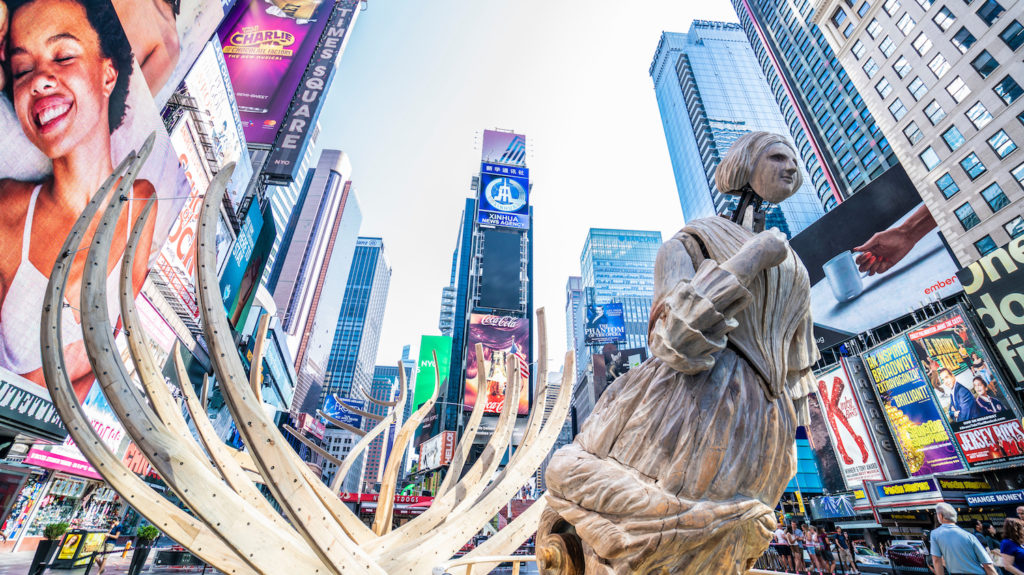
Mel Chin. Wake, 2018. Courtesy of Chelsea Lipman for Times Square Arts.
Chinese-American artist Mel Chin has taken over Times Square to create an underwater world in augmented reality. In a collaboration between the Queens Museum and No Longer Empty, the artist is showcasing two large scale pieces as part of the Queens Museum’s multi-location exhibition Mel Chin: All Over the Place, on view through September 5.
The two works on view in Times Square include Wake, a 24-foot installation that Artinfo says “evokes the hull of a shipwreck crossed with the skeletal remains of a marine mammal.” The animatronic figure on the bow of the ship is modeled on the likeness of Jenny Lind, a nineteenth century Swedish opera singer who often performed in New York. Unmoored, a collaboration with Microsoft, uses augmented reality to submerge Times Square underwater. According to Artnet, the work can be experienced through a downloadable app in which a phone can be held up and activated visually. Both works investigate the environmental and cultural histories of New York, while providing a respite from the city’s frenetic energy.
News of the Week
- The Museum of Modern Art’s event series PopRally is hosting “Studio Visit: Practice as Ritual” on July 21. “An evening of artistic and musical performances exposing the rituals and labor of art making,” the event will consist of three live performances that explore ways to reanimate works of art on display in the exhibition Studio Visit: Selected Gifts from Agnes Gund (closing July 22). Torkwase Dyson, Jonathan González, and DJ Yatta will perform.
- Last month, Kerry James Marshall unveiled his new sculpture, A Monumental Journey, in Des Moines, Iowa. The 30-foot monument is comprised of two tapered cylindrical volumes inscribed with the names of the twelve lawyers who founded the National Bar Association in 1925.
- This is the last week to see the Metropolitan Museum of Art’s Painting in Mexico: 1790-1790, closing on July 22. The first major museum exhibition to focus on eighteenth century Mexican colonial paintings, the show presents 110 works of art, many of which have never been exhibited before.
- Nicholas Hlobo’s new exhibition, Ulwamelko, is currently on view at Lehmann Maupin. On view through August 14, the show includes recent mixed media paintings and sculptures that explore the use of ribbon, wood, and rubber.
The Artist Speaks
Artist Collier Schorr recently spoke with AnOther magazine to discuss her practice, her relationship with the medium of collage, and how she approaches her subjects. Speaking about her work in the context of the fashion industry, the artist said:
“…I feel responsible for every picture. That’s why layout is so important, because I can make one picture that I feel is complicated, if I have another picture in that story that acknowledges it.
I just don’t want to make gratuitous pictures, I don’t want to make violent pictures, I don’t want to make pictures that take advantage of people. And I don’t want to upend things just to have upended them. It’s about fashion and it’s about poses, and so there are people who are invested in finding ways of upsetting that – and that’s really good for the industry, it’s good for the history. But I think there needs to be a follow-up to that. It’s not about only reacting against it; it’s also about asking, what does it say, what does it mean?”